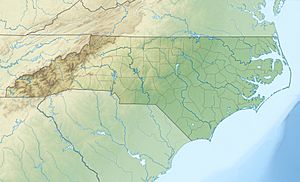Big Branch (Haw River tributary) facts for kids
Quick facts for kids Big Branch |
|
|---|---|
|
Location of Big Branch mouth
|
|
| Other name(s) | Tributary to Haw River |
| Country | United States |
| State | North Carolina |
| County | Alamance |
| Physical characteristics | |
| Main source | divide between Big Branch and Lick Creek about 2 miles west-northwest of Mandale, North Carolina 550 ft (170 m) 35°51′26″N 079°17′09″W / 35.85722°N 79.28583°W |
| River mouth | Haw River about 1.5 miles northeast of Mandale, North Carolina 390 ft (120 m) 35°51′49″N 079°14′59″W / 35.86361°N 79.24972°W |
| Length | 2.78 mi (4.47 km) |
| Basin features | |
| Progression | generally east |
| River system | Haw River |
| Basin size | 3.10 square miles (8.0 km2) |
| Tributaries |
|
| Bridges | NC 87, Mandale Road, Perry Road |
Big Branch is a small stream, or "tributary," located in Alamance County, North Carolina. It flows for about 2.78 mi (4.47 km) before joining the larger Haw River. Think of it as a smaller helper stream that feeds into a bigger river!
Contents
The Journey of Big Branch
Big Branch starts its journey in the western part of Alamance County, near a place called Mandale. It begins its flow about two miles west-northwest of Mandale.
Where it Flows
From its starting point, Big Branch generally flows towards the east. It travels through the landscape, collecting water as it goes.
Joining the Haw River
After its short journey, Big Branch meets and empties into the Haw River. This meeting point is about 1.5 miles northeast of Mandale.
Understanding the Watershed
A watershed is like a giant bowl that collects all the rain and snow that falls in an area. All this water then drains into a specific river or stream.
Size of the Watershed
The Big Branch watershed covers an area of about 3.10 square miles (8.0 km2). This means that all the rain that falls within this 3.10 square mile area will eventually flow into Big Branch.
Rainfall and Forests
This area gets a good amount of rain, about 47.1 inches each year. A large part of the watershed, about 47%, is covered by forests. These forests are important because they help keep the water clean and prevent soil from washing away.



